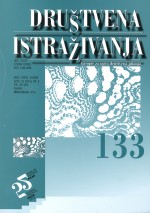Roditeljski kulturni kapital kao odrednica kulturnih preferencija mladih
Parental Cultural Capital as a Determinant of Cultural Preferences of Young People
Author(s): Krešimir Krolo, Sven Marcelić, Željka TonkovićSubject(s): Culture and social structure , School education, Family and social welfare, Sociology of Culture, Sociology of the arts, business, education, Socio-Economic Research, Sociology of Education
Published by: Institut društvenih znanosti Ivo Pilar
Keywords: cultural consumption; cultural capital; musical taste; high-school students; Zadar;
Summary/Abstract: The article starts from Pierre Bourdieu's concept of cultural capital and differentiation between embodied, objectified and institutionalized cultural capital. The main goal of the article is to research the connection between cultural preferences of high-school students and the different forms of cultural capital of their parents. Empirical data was gathered from a survey (N = 868) carried out in 2014 among high-school students in Zadar County (Croatia). Cultural preferences of high-school students were operationalized using three dimensions of cultural consumption: high culture, traditional-popular and rock-alternative. The results of hierarchical regression analysis confirmed the parental cultural capital to be an important predictor of high-school students' cultural preferences. In particular, our results indicate that the parentally embodied cultural capital is a better predictor than the objectified and institutionalized cultural capital or economic capital. Results point to a visible distinction between two types of cultural consumption: traditional-popular and high culture consumption, which is in line with previous studies. On the other hand, the rock-alternative type of cultural consumption is positively associated with exposure to high culture in a family environment, which indicates a change in the meaning of cultural content.
Journal: Društvena istraživanja - Časopis za opća društvena pitanja
- Issue Year: 25/2016
- Issue No: 3
- Page Range: 329-351
- Page Count: 23
- Language: Croatian

